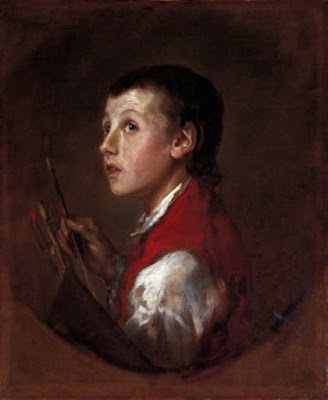It’s now a museum dedicated to the painter and his work. The house recently announced that its collection of artwork, manuscripts, painting tools, and other artifacts is viewable online. (Notably, that database of British art is on a Swiss system through Zetcom.ch.)
Many of the museum’s items are prints and engravings derived from Gainsborough’s paintings, but the museum also houses a few originals. One, on loan from its owner, is this portrait created around 1769 and known as “The Pitminster Boy.”
In a travel article for the Telegraph, Fiona Bruce wrote this picture is “believed to be of Gainsborough’s assistant during a sketching trip in Somerset.”
A young boy in a red waistcoat looks up and out of the frame, alert, watchful, holding his master’s brushes and pulling one out ready for use, presumably the brush Gainsborough needs for the next strokes of the portrait.Many scholars think this was one of the four paintings that Gainsborough sent to the first Royal Academy exhibition in London in 1769, described in the catalogue only as a “boy’s head.”
But that’s not the only digitization of the Gainsborough House’s collection folks can enjoy on the web. In her “Gainsborough Project,” The artist Emily Godden has created “sonifications” of the cracks in a handful of paintings, including the right hand of “The Pitminster Boy.” She explains:
The process begins using a graphics tablet to draw out the lines/cracks formed over time as a result of the deterioration of the paintings at Gainsborough’s House. These drawings focus on the hands in the paintings and have been drawn in Adobe Photoshop CS6 and are then exported as bitmap prints to be imported into bespoke software. Through a process of plotting the pixels from the bitmap files the software uses a means of pixel feedback to construct grids from the pixels to plot out waveforms, which are then output as .wav files which can then be listened to.I think the boy’s expression says it all.
This processing of data within the project allows a mediation to occur through data use and re-use which challenges typical expectations of image and media reproduction. Instead of merely exploiting the serial nature of print I have applied a haptic approach to the textures felt in the sound as being representative of the spaces that the sound has been extracted from. A feedback loop is established and the data transposed into a new form to create a state of flux.
The sonification of the intangible leads the sound files to act and function as prints which isolate the visual sense to engage in a haptic materiality which explores the vicissitudes of listening within virtual realities over the spatiality of Gainsborough’s House.

No comments:
Post a Comment